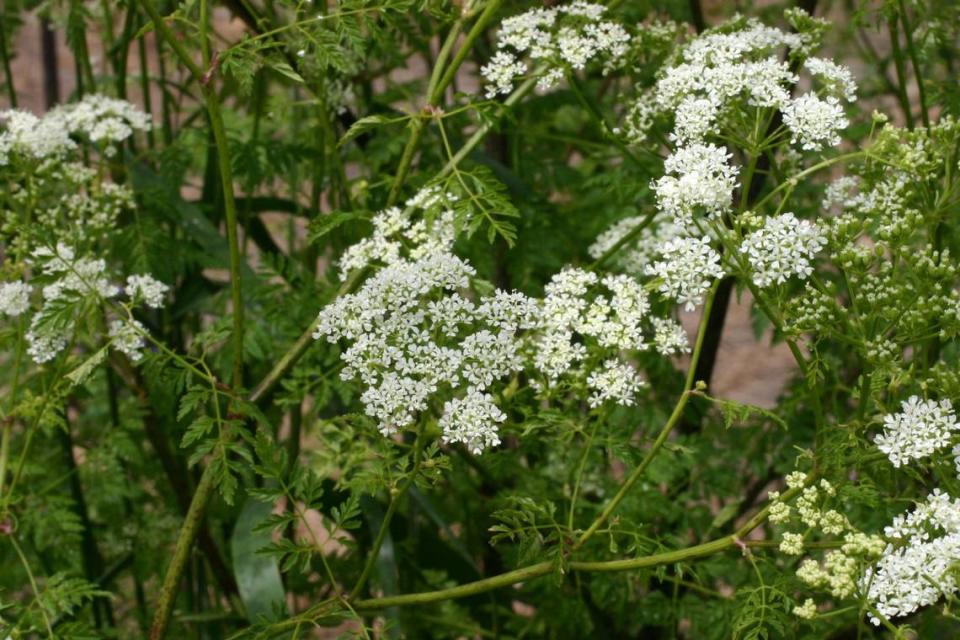Pennsylvania could be seeing ‘an explosion in slow motion’ of this poisonous weed
Along with school breaks and toasty temperatures, June and July in State College, and much of Pennsylvania, also bring the bright white blooms of a dangerous weed.
Growing as tall as 6 feet, poison hemlock tends to display a spray of flowers around June and July, making it especially visible to property owners and others this time of year.
The hemlock population has been “steadily increasing” across Pennsylvania for several decades, according to Dwight Lingenfelter, senior extension associate of weed science with the Penn State Extension, though it may be more noticeable this year given its lifecycle.
The noxious weed, scientific name Conium maculatum, is a biennial plant, meaning it has a two-year lifecycle and blooms the second year.
“As with many weeds, it may take years before people start to notice them taking over an area,” Lingenfelter told the Centre Daily Times last month. “Some weed scientists have described this as ‘an explosion in slow motion.’”
Here’s what to know about poison hemlock, including its dangers and how to safely remove it if you think it may be creeping across your property.
How to spot poison hemlock
Germinating from a seed, poison hemlock has a basal rosette leaf pattern (read: leaves radiating from the base of the stem) for its first year of life, according to Penn State Extension, the university’s science-based education outfit. After a winter, the stem will shoot up the following spring – growing from 2 to 6 feet – and will bloom umbels (or bundles) of what Ligenfelter describes as “showy white flowers.”
It will drop seeds, by which it reproduces, and the original plant will then die.

While it has lookalikes, poison hemlock can be important to identify as it poses a danger to humans and animals if ingested.
All parts of the hemlock plant are toxic, and the U.S. Department of Agriculture highlights it is especially dangerous to cattle, sheep, pigs, horses and other types of wildlife.
“Mature seeds are the most poisonous. Significant poisoning can result in muscle paralysis and suffocation,” Ligenfelter wrote in an email. “Especially in a drought year like we are currently experiencing, poison hemlock and other weeds may be the most prominent plants in the pasture if forage species are limited and livestock get curious.”
The U.S. Drought Monitor reports as of July 18 some parts of Pennsylvania are experiencing moderate drought, though the state Department of Environmental Protection has the entire state under a drought watch.
In addition to the dangers if ingested, contact with poison hemlock may cause irritation to the skin.
Poison hemlock is listed with other class B noxious weeds by the Pennsylvania Department of Agriculture, but Ligenfelter said “limited resources” may hamper management and enforcement.
Poison hemlock lookalikes
While poison hemlock’s flowers are somewhat distinctive, there are several lookalikes.
Poison hemlock can resemble wild carrot, also called Queen Anne’s lace, and parsley, the extension notes. Unlike these lookalikes, however, the stem of the hemlock plant will have purple spots, which may help distinguish it as dangerous.
Ligenfelter said another lookalike and relative, wild chervil, is growing at Penn State Research Farms. Another member of the carrot family, wild chervil is also invasive and is typically shorter than hemlock, reaching 4 feet.
How to remove poison hemlock from your property
If you suspect you may have poison hemlock growing on your property, you should remove it, though summer might not be the most ideal time to do so.
Ligenfelter suggested looking for the rosettes in the fall or early spring, before the hemlock has hit its year-two vertical growth.
“This is the best time (in the rosette stage) to control it with various tactics and not when it is large and has flowered and is setting seed,” he wrote. “Individual plants can be easily [dug] out with a shovel. Larger infestations can be cut with a mower or string trimmer or may require the use of a herbicide.”
Poison Hemlock: Facts About this Early Season Weed. Learn how to identify and manage this poisonous weed from Penn State Extension's Dwight Lingenfelter. https://t.co/Udr7NfFgVD pic.twitter.com/vKbPhUeoW2
— Penn State Crops (@PennStateCrops) April 24, 2021
If you opt to treat it with a herbicide, Ligenfelter recommends 2,4-D + dicamba, Crossbow (2,4-D+triclopyr) or glyphosate for spot treatment. Application of the herbicides is best done in the rosette stage in the fall or early in spring.
If trimming back or pulling hemlock, you should wear gloves and long sleeves and pants to prevent contact with your skin.

